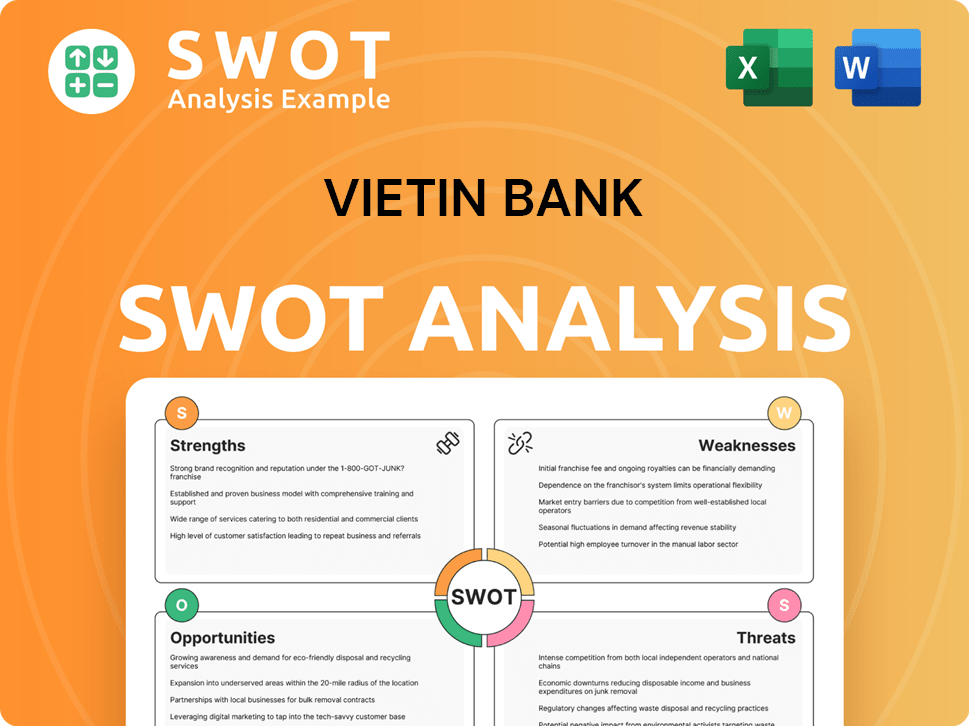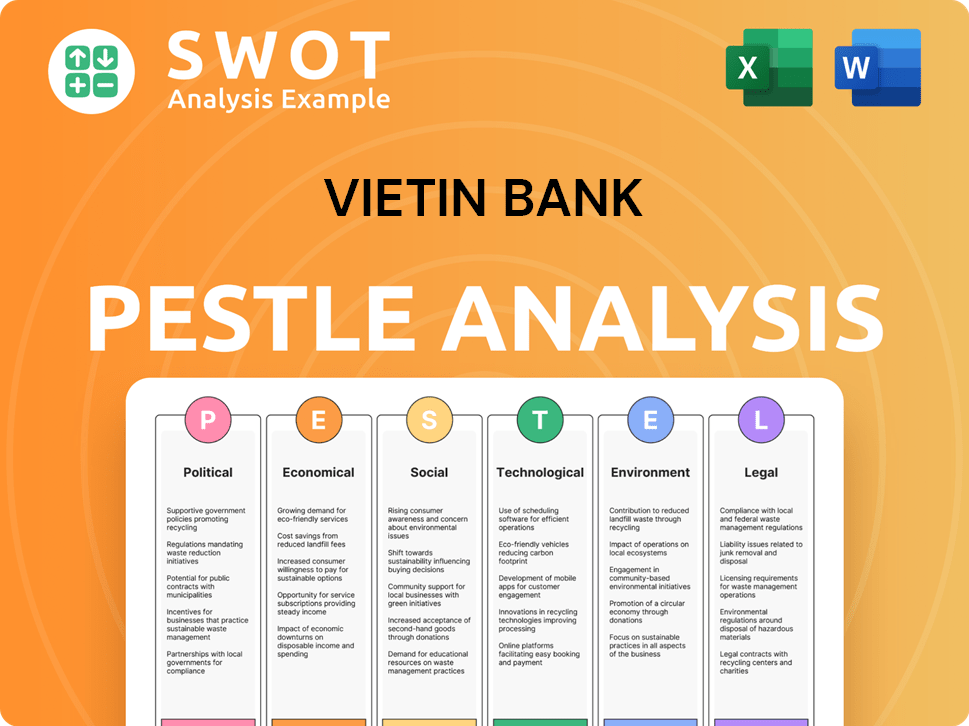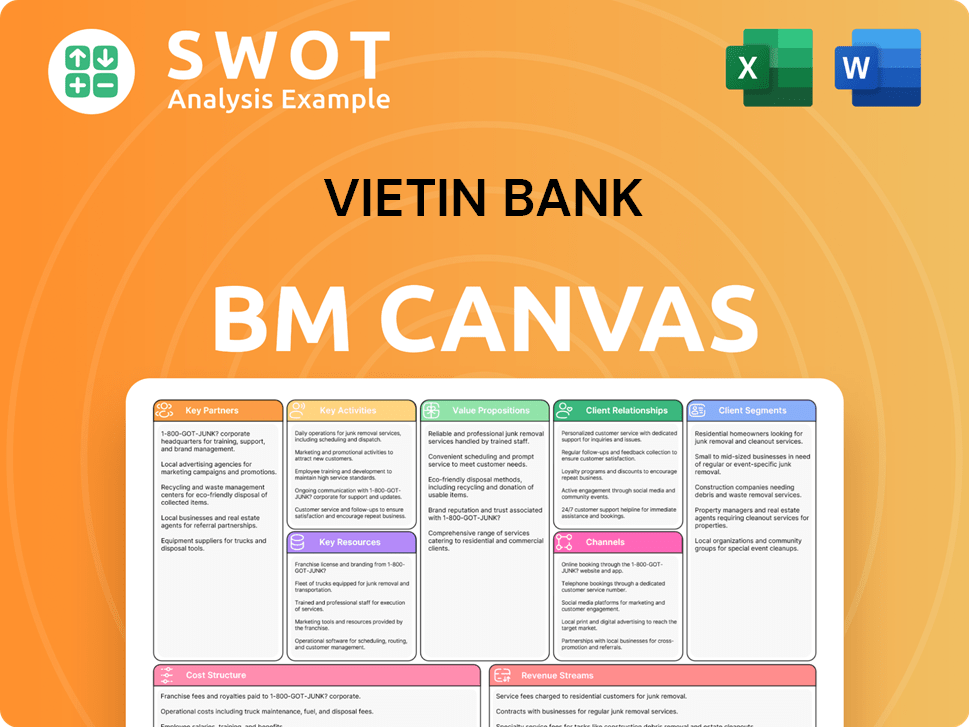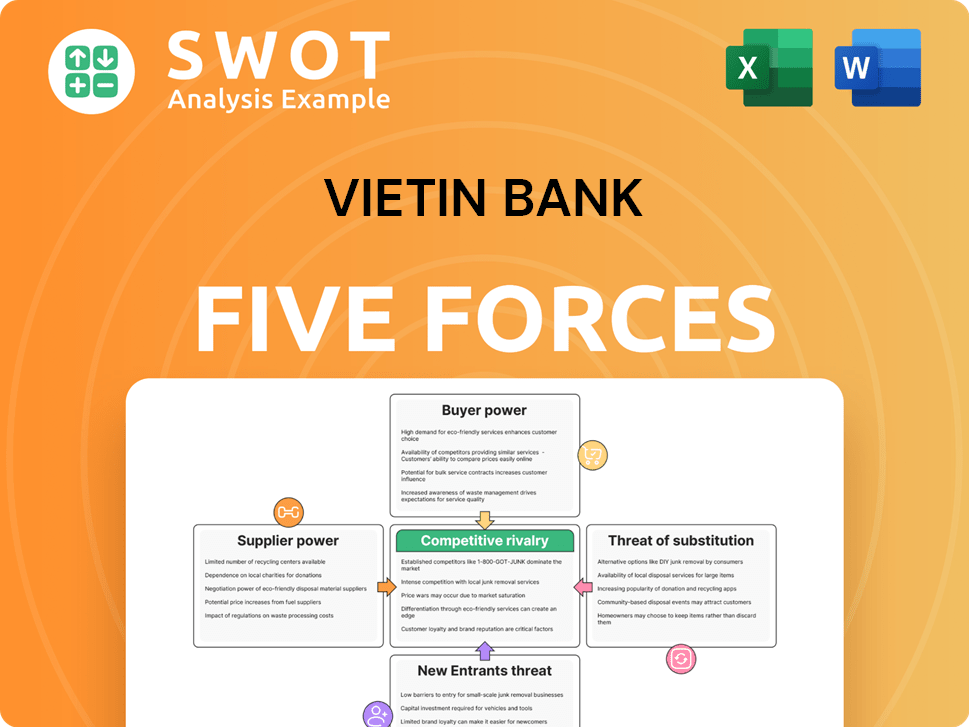Vietin Bank Bundle
How Does VietinBank Navigate Vietnam's Banking Battleground?
The Vietnamese banking sector is undergoing a seismic shift, fueled by digital innovation and fierce competition. Understanding the Vietin Bank SWOT Analysis is crucial for investors and strategists alike. As a major player, VietinBank's position in this dynamic landscape is critical to its future success. This analysis dives deep into the bank's standing.

This exploration of the VietinBank competitive landscape will help you understand its market share. We'll dissect the VietinBank competitive landscape, examining its primary rivals and strategic advantages. Furthermore, we'll analyze how VietinBank's financial performance compares to its competitors within the Vietnamese banking sector, providing actionable insights for informed decision-making.
Where Does Vietin Bank’ Stand in the Current Market?
VietinBank holds a strong market position within Vietnam's banking sector, consistently ranking among the top state-owned commercial banks. This solid standing is reflected in its substantial assets, deposits, and loan portfolios, making it a key player in the nation's financial landscape. The bank's performance in early 2024, with a pre-tax profit of VND 7.150 trillion, underscores its financial health and operational efficiency.
The bank's core operations encompass a wide array of financial services. These include traditional offerings like deposits and loans, along with payment services, international trade finance, and investment banking solutions. VietinBank's extensive branch and transaction office network, coupled with its digital banking platforms, allows it to serve a diverse customer base, from individual retail clients to large corporations.
By the end of 2023, VietinBank's total assets reached VND 2.01 quadrillion, showcasing its significant scale and influence in the Vietnamese banking industry. The bank's strategic focus on digital transformation, including investments in digital banking platforms and mobile applications, is a key element in maintaining its competitive edge and attracting a broader, tech-savvy demographic. This focus is crucial in the evolving VietinBank competitive landscape.
VietinBank, alongside other major state-owned banks like Vietcombank, BIDV, and Agribank, typically controls a significant portion of the total banking assets, deposits, and loans in Vietnam. While precise 2024-2025 market share figures are dynamic, the bank's consistent presence among the top performers highlights its strong market position.
The bank's primary services include deposits, loans, payment solutions, international trade finance, and investment banking. This comprehensive suite of offerings caters to a broad spectrum of clients, from retail customers to large enterprises. The bank's ability to adapt its services to meet evolving market demands is crucial for its long-term success.
VietinBank has an extensive network of branches and transaction offices across Vietnam, ensuring wide accessibility for its customers. Its international operations in key financial centers further extend its reach. This broad presence is critical for capturing a diverse customer base and supporting the bank's growth objectives.
VietinBank is actively investing in digital banking platforms and mobile applications to enhance customer experience and reach a wider, tech-savvy demographic. This strategic shift is essential for maintaining competitiveness in an increasingly digitalized financial landscape and is a key part of its strategy to gain market share.
VietinBank's strengths lie in its robust financial performance, extensive branch network, and diverse product offerings. These factors, combined with its strategic investments in digital banking, position it well in the competitive environment.
- Strong financial performance, as evidenced by its Q1 2024 pre-tax profit.
- Extensive branch network providing widespread accessibility.
- Diversified product portfolio catering to a wide range of customers.
- Strategic focus on digital transformation to enhance customer experience.
Vietin Bank SWOT Analysis
- Complete SWOT Breakdown
- Fully Customizable
- Editable in Excel & Word
- Professional Formatting
- Investor-Ready Format

Who Are the Main Competitors Challenging Vietin Bank?
The VietinBank competitive landscape is shaped by a diverse array of financial institutions vying for market share in Vietnam's dynamic banking sector. This environment includes both state-owned and private commercial banks, as well as the growing influence of fintech companies. Understanding these competitors is crucial for analyzing VietinBank's market position and strategic direction.
VietinBank's competitors range from established state-owned giants to agile private banks, each employing different strategies to attract customers and increase their presence in the market. The competitive dynamics are further complicated by the rise of fintech, which is reshaping traditional banking services. Analyzing these factors provides a comprehensive view of the challenges and opportunities facing VietinBank.
VietinBank faces a complex VietinBank analysis within the Vietnamese banking industry. The bank's ability to compete effectively depends on its capacity to innovate, adapt to changing market conditions, and maintain a strong customer base. Understanding its competitors' strengths and weaknesses is essential for formulating effective strategies.
The 'Big Four' state-owned banks, including Vietcombank, Agribank, and BIDV, are key VietinBank competitors. These banks benefit from government support and extensive branch networks. They compete across various segments, including corporate lending, retail banking, and international trade finance.
Vietcombank is a strong competitor, particularly in corporate and international trade finance. It leverages its strong foreign exchange capabilities and often leads in profitability among state-owned banks. In 2024, Vietcombank reported a net profit of approximately VND 39.6 trillion, showcasing its strong financial performance.
BIDV competes in large infrastructure projects and state-owned enterprise financing. It has an extensive network and often vies for market share in these areas. BIDV's total assets were around VND 2,200 trillion in 2024, reflecting its significant presence in the market.
Agribank focuses on the agricultural and rural sectors, competing in deposit mobilization and lending in these segments. It has a vast network in rural areas. Agribank's total outstanding loans in 2024 were approximately VND 1,600 trillion, highlighting its importance in rural financing.
Leading private commercial banks like ACB, MBBank, Techcombank, and Sacombank pose significant competition. These banks often excel in customer service, digital innovation, and competitive interest rates. They challenge VietinBank's market share through agile strategies.
Techcombank is known for its strong digital banking initiatives and focus on affluent customers. It challenges VietinBank's traditional customer base with innovative digital products. Techcombank's net profit in 2024 was approximately VND 28 trillion, demonstrating its strong growth.
MBBank has been aggressive in expanding its digital offerings and attracting younger demographics. It competes with VietinBank through innovative digital solutions. MBBank's total assets reached approximately VND 800 trillion by the end of 2024, reflecting its rapid expansion.
The VietinBank's market share is also influenced by the emergence of fintech companies. These companies offer specialized payment solutions and digital lending services, although their direct competition with traditional banking services is still evolving. These fintech firms are gradually changing the competitive landscape.
VietinBank's competitive environment in 2024 is characterized by intense competition and rapid technological advancements. The bank's strategic responses include investments in digital transformation, customer-centric services, and strategic partnerships. These strategies are crucial for maintaining and growing its market share.
- Digital Transformation: VietinBank is investing heavily in digital banking platforms to enhance customer experience and operational efficiency.
- Customer-Centric Services: The bank focuses on providing personalized financial products and services to retain and attract customers.
- Strategic Partnerships: VietinBank collaborates with fintech companies and other financial institutions to expand its service offerings and reach.
- Market Share: VietinBank's market share in terms of total assets was around 12% as of the end of 2024, positioning it as a major player in the Vietnamese banking sector.
Vietin Bank PESTLE Analysis
- Covers All 6 PESTLE Categories
- No Research Needed – Save Hours of Work
- Built by Experts, Trusted by Consultants
- Instant Download, Ready to Use
- 100% Editable, Fully Customizable

What Gives Vietin Bank a Competitive Edge Over Its Rivals?
Understanding the competitive landscape of VietinBank requires a deep dive into its core strengths. The bank's robust brand reputation and implicit backing from the government provide a significant advantage, fostering customer loyalty and trust, especially among large corporations. This strong foundation is critical in the highly competitive Vietnamese banking sector. Furthermore, VietinBank's extensive network and strategic partnerships play a key role in its market positioning.
VietinBank's extensive branch network is a key differentiator, offering unparalleled reach across Vietnam. This broad presence is particularly advantageous in rural areas, where access to banking services may be limited. The bank's ability to mobilize deposits and disburse loans through this network is a major competitive advantage. The bank has also been investing in digital transformation to improve its service offerings and operational efficiency.
To understand the competitive dynamics, it's essential to look at VietinBank's strategic moves. The bank leverages its established infrastructure and reputation while adapting to technological advancements. The bank's ability to maintain and grow its market share in the face of rapid industry shifts, driven by technology and changing customer expectations, is crucial. For a deeper understanding of its growth strategy, consider reading about the Growth Strategy of Vietin Bank.
VietinBank benefits from a strong brand reputation and implicit government support, fostering trust and loyalty, particularly among large corporate clients. This backing provides a stable foundation in the competitive Vietnamese banking sector. This support also helps in weathering economic fluctuations.
With one of the largest branch networks in Vietnam, VietinBank ensures widespread accessibility, especially in rural areas. This extensive reach supports deposit mobilization and loan disbursement, providing a significant competitive edge. This broad distribution network is a key factor in its market share.
VietinBank's size allows it to undertake large-scale financing projects and offer competitive pricing. Its operational efficiency supports its ability to compete effectively. These factors contribute to its ability to manage costs and offer attractive financial products.
The bank's ongoing investments in digital transformation aim to enhance service offerings and operational efficiency. While digital capabilities are evolving, these investments are crucial for maintaining a competitive position in the digital realm. This is key to staying competitive.
VietinBank's competitive advantages are multi-faceted, including its brand reputation, extensive network, and strategic investments. These strengths help it maintain a strong market position. The bank's ability to adapt to technological changes is also critical.
- Brand Trust: Strong reputation and government backing.
- Broad Reach: Extensive branch network across Vietnam.
- Operational Efficiency: Economies of scale and cost management.
- Digital Focus: Investments in digital transformation and fintech.
Vietin Bank Business Model Canvas
- Complete 9-Block Business Model Canvas
- Effortlessly Communicate Your Business Strategy
- Investor-Ready BMC Format
- 100% Editable and Customizable
- Clear and Structured Layout

What Industry Trends Are Reshaping Vietin Bank’s Competitive Landscape?
The Vietnamese banking sector is currently experiencing significant shifts, creating both challenges and opportunities for institutions like VietinBank. Key trends include digital transformation, regulatory changes, and evolving consumer preferences. Understanding these dynamics is crucial for assessing the VietinBank's competitive landscape and future prospects.
The competitive environment is also influenced by macroeconomic factors, technological advancements, and the strategic initiatives of both domestic and foreign banks. These elements shape VietinBank's ability to maintain and grow its market share. The bank must adapt to these changes to remain competitive and meet the evolving needs of its customers.
Digital transformation is a primary driver, with mobile banking and online services becoming increasingly important. Regulatory changes from the State Bank of Vietnam impact capital requirements and lending practices. Consumer preferences are shifting towards personalized financial solutions and environmentally conscious banking.
Intense competition from private banks and fintechs poses a significant challenge. Continuous investment in cybersecurity is crucial to combat digital threats. Managing credit quality in a dynamic economic environment is essential.
Expanding into underserved segments offers growth potential. Leveraging data analytics for personalized services can improve customer engagement. Strategic partnerships with fintech companies can accelerate innovation and service offerings.
VietinBank's extensive network and strong brand recognition are key assets. Focus on digital transformation and optimizing operations are critical for maintaining a competitive edge. Adapting to changing market conditions and customer needs is essential for long-term success.
The Vietnamese banking sector is seeing increased competition, particularly in digital banking. In 2024, the State Bank of Vietnam is expected to continue its focus on regulating and promoting digital financial services. VietinBank's ability to compete will depend on its strategic responses to these trends. The bank's market share, and its ability to maintain its position in the
VietinBank must continuously invest in technology and cybersecurity to stay competitive. Strategic partnerships with fintech companies can provide access to new technologies and markets. Maintaining strong customer relationships is vital for retaining and attracting customers.
- Focus on digital transformation to enhance customer experience.
- Strengthen cybersecurity measures to protect against digital threats.
- Explore strategic partnerships to accelerate innovation and expand services.
- Adapt to evolving regulatory requirements to ensure compliance.
Vietin Bank Porter's Five Forces Analysis
- Covers All 5 Competitive Forces in Detail
- Structured for Consultants, Students, and Founders
- 100% Editable in Microsoft Word & Excel
- Instant Digital Download – Use Immediately
- Compatible with Mac & PC – Fully Unlocked

Related Blogs
- What are Mission Vision & Core Values of Vietin Bank Company?
- What is Growth Strategy and Future Prospects of Vietin Bank Company?
- How Does Vietin Bank Company Work?
- What is Sales and Marketing Strategy of Vietin Bank Company?
- What is Brief History of Vietin Bank Company?
- Who Owns Vietin Bank Company?
- What is Customer Demographics and Target Market of Vietin Bank Company?
Disclaimer
All information, articles, and product details provided on this website are for general informational and educational purposes only. We do not claim any ownership over, nor do we intend to infringe upon, any trademarks, copyrights, logos, brand names, or other intellectual property mentioned or depicted on this site. Such intellectual property remains the property of its respective owners, and any references here are made solely for identification or informational purposes, without implying any affiliation, endorsement, or partnership.
We make no representations or warranties, express or implied, regarding the accuracy, completeness, or suitability of any content or products presented. Nothing on this website should be construed as legal, tax, investment, financial, medical, or other professional advice. In addition, no part of this site—including articles or product references—constitutes a solicitation, recommendation, endorsement, advertisement, or offer to buy or sell any securities, franchises, or other financial instruments, particularly in jurisdictions where such activity would be unlawful.
All content is of a general nature and may not address the specific circumstances of any individual or entity. It is not a substitute for professional advice or services. Any actions you take based on the information provided here are strictly at your own risk. You accept full responsibility for any decisions or outcomes arising from your use of this website and agree to release us from any liability in connection with your use of, or reliance upon, the content or products found herein.